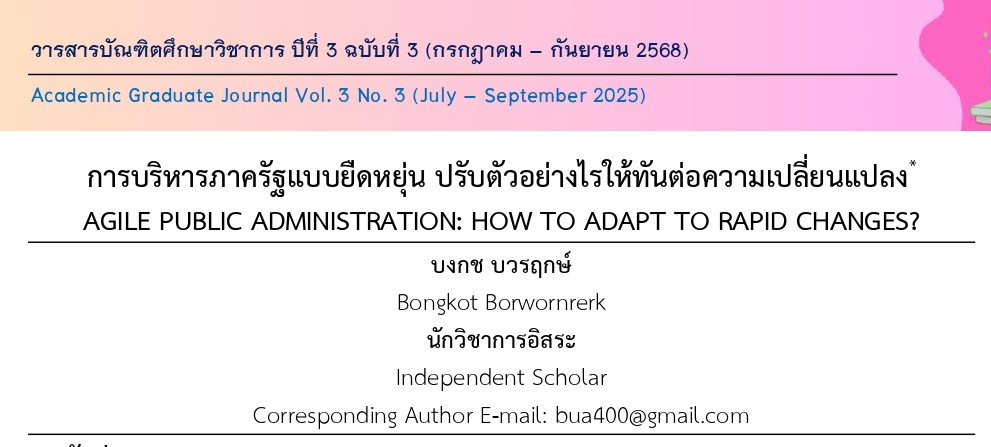AGILE PUBLIC ADMINISTRATION: HOW TO ADAPT TO RAPID CHANGES ?
Keywords:
Agile Public Administration, Adaptation, Digital TransformationAbstract
Rapid changes in technology, society, and the economy have significantly impacted public administration worldwide, compelling government agencies to respond more swiftly and effectively to citizens’ needs. Agile Public Administration has been proposed as a key approach to restructuring organizational processes and workflows to be more flexible, compact, and value driven. This article aimed to explore the core elements and practical implementations of Agile in the public sector, with emphasis on organizational structures, cross-functional teams, fail-fast cultures, and the adaptation of legal frameworks and performance indicators. The findings suggested that leadership support, inter-agency collaboration, and ongoing technological innovation were critical factors in fostering a sustainable Agile transition in government. By incorporating these elements, public agencies can better deliver timely and high-quality services, ultimately enhancing public value.
References
สำนักงานพัฒนารัฐบาลดิจิทัล (องค์การมหาชน). (2564). แนวทางการพัฒนารัฐบาลดิจิทัล พ.ศ. 2564–2568. สืบค้น 10 เมษายน 2568, จาก https://www.dga.or.th
Bason, C. (2018). Leading Public Sector Innovation: Co-creating for a Better Society. Bristol: Policy Press.
Beck, K. et al. (2001). Manifesto for Agile Software Development. Retrieved April 10, 2025, from http://agilemanifesto.org
Chan, C., & Holosko, M. J. (2016). A Review of Information and Communication Technology Enhanced Social Work Interventions. Research on Social Work Practice, 26(1), 88–100.
Christensen, T., & Lægreid, P. (2011). The Ashgate Research Companion to New Public Management. Surrey: Ashgate.
Kalvet, T. (2012). Innovation: A Factor Explaining E-Government Success in Estonia. Electronic Government, 9(2), 142–157.
Kettl, D. F. (2017). The Transformation of Governance: Public Administration for the Twenty-First Century America. Maryland: Johns Hopkins University Press.
Lindquist, E. (2010). Putting Citizens First: Engagement in Policy and Service Delivery for the 21st Century. Optimum Online, 40(2), 49–56.
Moore, M. H. (1995). Creating Public Value: Strategic Management in Government. Cambridge: Harvard University Press.
Osborne, S. P. (Ed.). (2010). The New Public Governance? : Emerging Perspectives on the Theory and Practice of Public Governance. London: Routledge.
Pollitt, C., & Bouckaert, G. (2011). Public Management Reform: A Comparative Analysis New Public Management, Governance, and the Neo-Weberian State (3rd ed.). Oxford University Press.







